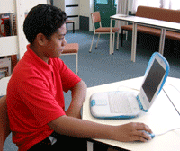In 2001, NEMP developed a simulated (‘compact’) model
of the WWW by archiving a database of Web pages on the hard disk
of NEMP laptop computers. Children were asked to find information
archived in this database with a search engine called Seeker.
The present study evaluated the effectiveness and validity of
the compact model by comparing children’s search performance
on it with their performance on Internet using the search engine
Google. |
Otago and Southland
Year 4 (N = 54) and Year 8 (N = 45) students were randomly selected from
schools participating in NEMP, and then randomly assigned to either the
Seeker or Google groups. The students were then asked to complete the
same information-searching tasks used by NEMP in 2001.
![]()
| • While
there was no significant difference between model-using students
and Internet-using students at either age, Year 4 students were
more likely to locate sites containing answers to one of the task
questions when using the model. • Overall, Year 8 students performed better than Year 4 students. • There were no gender differences in the use of search strategies on the model and Internet or in the ability of students to find answers. • Students
did not use the same searching behaviour on Internet as on the model,
possibly because Google and Seeker differ in key ways. For example,
the two engines return different websites in response to keywords,
and using more keywords narrows the search with Google, but broadens
it with Seeker. |
![]()
